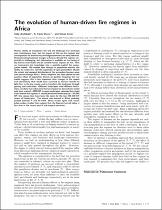JavaScript is disabled for your browser. Some features of this site may not work without it.
- ResearchSpace
- →
- Research Publications/Outputs
- →
- Journal Articles
- →
- View Item
| dc.contributor.author |
Archibald, S

|
|
| dc.contributor.author |
Staver, C

|
|
| dc.contributor.author |
Levin, SA

|
|
| dc.date.accessioned | 2012-07-30T07:21:33Z | |
| dc.date.available | 2012-07-30T07:21:33Z | |
| dc.date.issued | 2012-01 | |
| dc.identifier.citation | Archibald, S, Staver, C and Levin, SA. 2012. Evolution of human-driven fire regimes in Africa. Proceedings of the National Academy of Sciences of the United States of America, vol 109(3), pp 847-852 | en_US |
| dc.identifier.issn | 0027-8424 | |
| dc.identifier.uri | http://www.pnas.org/content/109/3/847.full.pdf+html | |
| dc.identifier.uri | http://hdl.handle.net/10204/6018 | |
| dc.description | Copyright: 2011 National Academy of Sciences of the United States of America. This is the post-print version of the work. The definitive version is published in Proceedings of the National Academy of Sciences of the United States of America, vol 109(3), pp 847-852 | en_US |
| dc.description.abstract | Human ability to manipulate fire and the landscape has increased over evolutionary time, but the impact of this on fire regimes and consequences for biodiversity and biogeochemistry are hotly debated. Reconstructing historical changes in human-derived fire regimes empirically is challenging, but information is available on the timing of key human innovations and on current human impacts on fire; here we incorporate this knowledge into a spatially explicit fire propagation model. We explore how changes in population density, the ability to create fire, and the expansion of agropastoralism altered the extent and seasonal distribution of fire as modern humans arose and spread through Africa. Much emphasis has been placed on the positive effect of population density on ignition frequency, but our model suggests this is less important than changes in fire spread and connectivity that would have occurred as humans learned to light fires in the dry season and to transform the landscape through grazing and cultivation. Different landscapes show different limitations; we show that substantial human impacts on burned area would only have started 4,000 B.P. in open landscapes, whereas they could have altered fire regimes in closed/dissected landscapes by 40,000 B.P. Dry season fires have been the norm for the past 200–300 ky across all landscapes. The annual area burned in Africa probably peaked between 4 and 40 kya. These results agree with recent paleocarbon studies that suggest that the biomass burned today is less than in the recent past in subtropical countries. | en_US |
| dc.language.iso | en | en_US |
| dc.publisher | National Academy of Sciences of the United States of America | en_US |
| dc.relation.ispartofseries | Workflow;8020 | |
| dc.subject | Human evolution | en_US |
| dc.subject | Human ignition | en_US |
| dc.subject | Savanna | en_US |
| dc.subject | Fire spread model | en_US |
| dc.subject | Human-derived fire regimes | en_US |
| dc.subject | Biogeochemistry | en_US |
| dc.title | Evolution of human-driven fire regimes in Africa | en_US |
| dc.type | Article | en_US |
| dc.identifier.apacitation | Archibald, S., Staver, C., & Levin, S. (2012). Evolution of human-driven fire regimes in Africa. http://hdl.handle.net/10204/6018 | en_ZA |
| dc.identifier.chicagocitation | Archibald, S, C Staver, and SA Levin "Evolution of human-driven fire regimes in Africa." (2012) http://hdl.handle.net/10204/6018 | en_ZA |
| dc.identifier.vancouvercitation | Archibald S, Staver C, Levin S. Evolution of human-driven fire regimes in Africa. 2012; http://hdl.handle.net/10204/6018. | en_ZA |
| dc.identifier.ris | TY - Article AU - Archibald, S AU - Staver, C AU - Levin, SA AB - Human ability to manipulate fire and the landscape has increased over evolutionary time, but the impact of this on fire regimes and consequences for biodiversity and biogeochemistry are hotly debated. Reconstructing historical changes in human-derived fire regimes empirically is challenging, but information is available on the timing of key human innovations and on current human impacts on fire; here we incorporate this knowledge into a spatially explicit fire propagation model. We explore how changes in population density, the ability to create fire, and the expansion of agropastoralism altered the extent and seasonal distribution of fire as modern humans arose and spread through Africa. Much emphasis has been placed on the positive effect of population density on ignition frequency, but our model suggests this is less important than changes in fire spread and connectivity that would have occurred as humans learned to light fires in the dry season and to transform the landscape through grazing and cultivation. Different landscapes show different limitations; we show that substantial human impacts on burned area would only have started 4,000 B.P. in open landscapes, whereas they could have altered fire regimes in closed/dissected landscapes by 40,000 B.P. Dry season fires have been the norm for the past 200–300 ky across all landscapes. The annual area burned in Africa probably peaked between 4 and 40 kya. These results agree with recent paleocarbon studies that suggest that the biomass burned today is less than in the recent past in subtropical countries. DA - 2012-01 DB - ResearchSpace DP - CSIR KW - Human evolution KW - Human ignition KW - Savanna KW - Fire spread model KW - Human-derived fire regimes KW - Biogeochemistry LK - https://researchspace.csir.co.za PY - 2012 SM - 0027-8424 T1 - Evolution of human-driven fire regimes in Africa TI - Evolution of human-driven fire regimes in Africa UR - http://hdl.handle.net/10204/6018 ER - | en_ZA |






